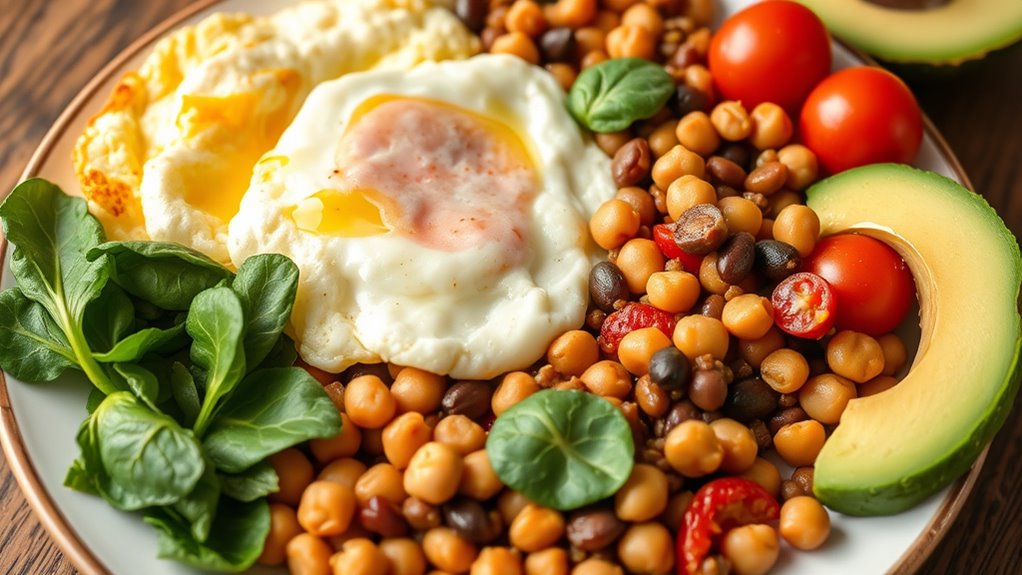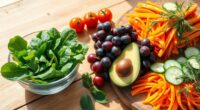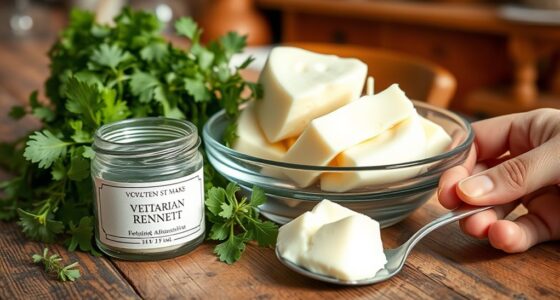To create high-protein vegetarian meals with pulses and eggs, focus on incorporating ingredients like lentils, chickpeas, beans, and hard-boiled eggs into your dishes. Batch-cook pulses and prepare eggs in advance for quick access. Combine them with vegetables, grains, and flavorful spices to make hearty salads, stews, omelets, or bowls. This simple approach boosts your protein intake, keeps meals diverse, and makes nutrition easy—explore more ideas to keep your diet satisfying and balanced.
Key Takeaways
- Combine cooked lentils or chickpeas with vegetables and eggs in salads or grain bowls for a quick, protein-packed meal.
- Prepare egg and pulse-based breakfast options like veggie omelets with lentil fillings or chickpea scramble.
- Use batch-cooked pulses and hard-boiled eggs as toppings for soups, salads, or wraps to boost protein content.
- Make hearty vegetarian stews or curries with beans and add eggs for extra richness and nutrition.
- Incorporate pulses and eggs into baked dishes like frittatas, casseroles, or veggie muffins for versatile high-protein recipes.

If you’re looking to boost your protein intake without eating meat, there are plenty of delicious vegetarian options that pack a punch. Pulses like lentils, chickpeas, and beans are excellent sources of plant-based protein, making them versatile staples in your diet. Eggs also stand out as a complete protein, providing all essential amino acids in a compact, nutrient-dense package. Incorporating these ingredients into your meals can help you meet your daily protein goals effortlessly. To make the most of these high-protein foods, consider meal prep tips that streamline your cooking process and ensure you always have nutritious options on hand. Cooking a batch of lentils or chickpeas at the start of the week allows you to quickly add them to salads, wraps, or grain bowls. Hard-boiled eggs are another convenient protein boost—prepare a dozen and store them in the fridge for quick snacks or additions to any meal. Using these ingredients consistently helps you develop a routine that makes high-protein vegetarian eating simple and satisfying. Additionally, choosing pulses and eggs that are rich in protein can help you stay fuller longer and support muscle maintenance.
When planning your meals, focus on combining pulses and eggs with other nutrient-dense foods to maximize flavor and nutrition. For example, you can toss cooked lentils into a spinach and feta omelet or add chickpeas to a roasted vegetable Buddha bowl. These pairings not only increase your protein intake but also create well-rounded, satisfying dishes. Meal prep tips like portioning out cooked pulses into airtight containers or pre-peeled, hard-boiled eggs can save you time during busy mornings or at lunchtime. Additionally, incorporating a variety of pulses in your diet ensures you benefit from different flavors and nutrients, keeping your meals interesting and enjoyable.
Incorporating plant-based protein sources like pulses and eggs into your vegetarian meals is straightforward once you establish a routine. Keep your pantry stocked with dried or canned pulses, and always have eggs available for quick cooking. Using meal prep tips, such as batch cooking and pre-portioning ingredients, ensures that your high-protein vegetarian meals are both convenient and consistent. Whether you’re making a lentil soup, chickpea salad, or an egg scramble, you’ll find that these ingredients are flexible and easy to incorporate into diverse dishes. By planning ahead and leveraging these protein-rich foods, you can maintain a balanced, satisfying vegetarian diet that helps you meet your nutritional goals without sacrificing flavor or variety.
Frequently Asked Questions
Are Pulses Suitable for People With Legume Allergies?
If you have a legume allergy, pulses aren’t suitable because they can trigger allergic reactions due to Legume allergy considerations. Instead, you should look for pulse allergy alternatives like seeds, nuts, or soy if tolerated. Always consult your healthcare provider before trying new foods, and carefully read labels to avoid cross-contamination. Staying informed helps you enjoy high-protein vegetarian meals safely without risking an adverse allergic response.
How Do I Incorporate Eggs Into a Vegan Meal?
Did you know that eggs are a complete protein, containing all essential amino acids? To incorporate eggs into a vegan meal, you’ll need to use egg substitutes like tofu scramble or chickpea flour-based batter. These vegan protein sources mimic eggs’ texture and nutrition. You can add them to breakfast dishes or baked goods, making your meal wholesome while keeping it vegan-friendly and high in protein.
What Are the Best Pulse Varieties for High Protein?
You should choose protein-rich pulses like lentils, chickpeas, black beans, and kidney beans, as they’re excellent legume varieties for high protein intake. These pulses are versatile, easy to prepare, and packed with nutrients, making them perfect for your meals. Incorporate them into salads, stews, or wraps to boost your protein levels naturally. Their rich fiber and mineral content also support overall health and digestion.
Can Vegetarian Meals Meet All Essential Amino Acids?
Yes, vegetarian meals can fulfill all essential amino acids by combining various plant-based proteins. You can pair pulses, eggs, grains, and seeds to create a complete amino acid profile. For example, eating beans with rice or hummus with whole wheat bread ensures you get a balanced mix of amino acids. Focusing on diverse sources of plant-based protein helps you naturally satisfy your essential amino acid needs without animal products.
How Do I Store Cooked Pulses for Freshness?
Storing cooked pulses is like preserving a precious gem. Use airtight storage containers to keep them fresh and prevent moisture loss. After cooking, let the pulses cool down to room temperature, then transfer them to these containers. Place them in the refrigerator promptly, ideally within two hours, to maintain their flavor and texture. Follow refrigeration tips like labeling with dates to guarantee you consume them while still fresh.
Conclusion
Including pulses and eggs in your vegetarian meals can boost your protein intake considerably—did you know they provide up to 20 grams of protein per serving? By incorporating these ingredients, you not only support muscle growth and energy but also enjoy delicious, satisfying meals. So, next time you plan your menu, remember that a simple pulse or an egg can make all the difference in meeting your daily protein goals effortlessly.
Ilana has been a vegan for over 10 years. She originally made the switch for health reasons, but soon found herself becoming more and more passionate about the ethical and environmental implications of a vegan lifestyle. Ilana is the author of The Graceful Kitchen, a blog all about veganism. She loves to cook up delicious and nutritious vegan meals, and share her recipes with others who are interested in leading a cruelty-free life. Ilana is also a strong advocate for using whole foods as the foundation of a healthy diet, and believes that going vegan is one of the best ways to achieve this.










